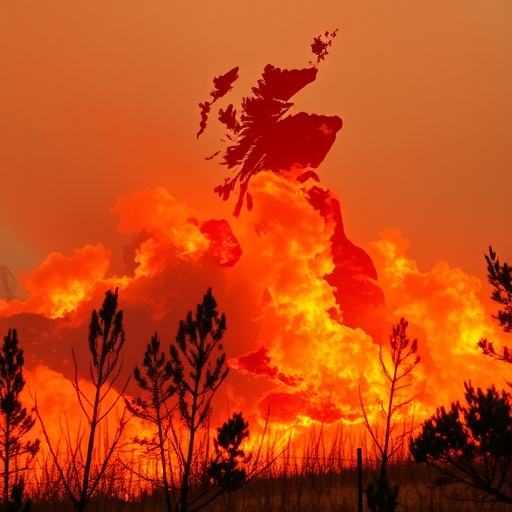As the impacts of climate change become more pronounced, the frequency and intensity of extreme weather events such as heatwaves have escalated globally. Recent research published in “Communications Earth & Environment” sheds light on an alarming phenomenon experienced in the United Kingdom during a record-breaking heatwave. The findings of Ivison and colleagues reveal critical interactions between various environmental factors that contribute to elevated wildfire risks, posing severe consequences for ecosystems, local communities, and emergency services.
The study meticulously documents a heatwave that gripped the UK, where temperatures soared to previously unrecorded levels. This unprecedented situation not only tested the resilience of the country’s infrastructure but also sparked alarm among researchers and policymakers about the potential for wildfire outbreaks. The analysis highlights the climate variables and human activities that converged to create ideal conditions for wildfires, prompting urgent discussions on prepared responses.
Temperature, humidity levels, and wind patterns are traditionally seen as critical factors influencing fire behavior. However, this research emphasizes the interconnected nature of these drivers, particularly how fuel moisture content played a pivotal role in exacerbating the risk of wildfires. During the heatwave, the synthesis of various meteorological data revealed a strikingly low percentage of moisture in fuels, creating a highly flammable environment prone to ignition.
The research team conducted a thorough investigation into the historical climate data to establish a correlation between rising temperatures and corresponding declines in fuel moisture. They found that not only had temperatures risen, but they had also experienced prolonged dry spells leading to desiccated landscapes. This finding is particularly concerning, as it suggests that without adequate rainfall or moisture replenishment, the risks of wildfire will continue to rise with each passing heatwave.
Additionally, the study accounted for human influence on the landscape, particularly how land use changes and forestry management practices contributed to the state of fuel moisture. The researchers found that areas with dense vegetation or poorly maintained woodlands presented a higher likelihood of rapid fire spread. Consequently, understanding these factors becomes essential for developing proactive fire management strategies.
One of the critical aspects of this research is the establishment of a framework for predicting wildfire risks. By engaging with advanced modeling techniques and artificial intelligence, the analysis creates a robust platform for projecting fire potential under various climate scenarios. This predictive capability not only aids firefighters in resource allocation but also informs local communities about potential evacuation plans during peak risks.
While the focus has predominantly been on the immediate degradation of landscapes due to wildfires, this study outlines the broader implications of unchecked wildfire proliferation. The researchers anticipate a domino effect on local wildlife, air quality, and even human health, as wildfire smoke can exacerbate respiratory issues and other health concerns among vulnerable populations.
In light of these findings, the authors urge immediate attention from government agencies and local authorities to establish better management practices. One of the recommendations includes enhancing public awareness about fire risks and preventive measures that individuals can take. It is crucial that communities engage in discussions on fire safety and establish networks for reporting fire hazards.
International cooperation also surfaces as a recurring theme in addressing wildfire risks. The language of climate change is decidedly global, and understanding that the UK is not alone in facing these challenges emphasizes the need for shared knowledge and resources. Collaborative frameworks can help align strategies across borders, allowing for a more concerted approach to wildfire preparedness and response.
Moreover, the study paves the way for future research on the socioeconomic impacts of wildfires in temperate zones. As ecosystems adapt to changing climates, questions arise about the resilience of local economies and their ability to rebound after wildfire occurrences. Stakeholders must recognize that safeguarding against wildfires means not only protecting natural resources but also ensuring community stability and growth.
As this ongoing narrative unfolds, the urgency for action cannot be overstated. The intricacies of climate change responses require an intersection of science, policy, and public engagement. Initiatives aimed at improving land management, fostering community resilience, and enhancing emergency preparedness must be at the forefront of national agendas.
Ultimately, this groundbreaking research contributes significantly to the growing body of knowledge on wildfire dynamics in temperate regions. It highlights the necessity for forward-thinking strategies that account for the multifaceted drivers of wildfire risks. Only by embracing a holistic approach can society hope to mitigate the threats posed by these natural disasters and secure a sustainable future in the face of climate uncertainty.
In summary, the UK’s recent heatwave has unveiled critical lessons about the intersection of climate variables, land management, and wildfire risks. Researchers Ivison and his team articulate how an unprecedented convergence of conditions led to a heightened state of alert regarding wildfires. This study stands as a call to action for improved practices and collaborative responses necessary to confront the challenges posed by a changing climate.
Subject of Research: Wildfire risks during extreme heatwaves in the UK
Article Title: Unprecedented UK heatwave harmonised drivers of fuel moisture creating extreme temperate wildfire risk
Article References:
Ivison, K., Little, K., Orpin, A. et al. Unprecedented UK heatwave harmonised drivers of fuel moisture creating extreme temperate wildfire risk.
Commun Earth Environ 6, 727 (2025). https://doi.org/10.1038/s43247-025-02746-8
Image Credits: AI Generated
DOI: 10.1038/s43247-025-02746-8
Keywords: Wildfire risk, heatwave, climate change, fuel moisture, environmental factors, emergency preparedness, community resilience, land management.




